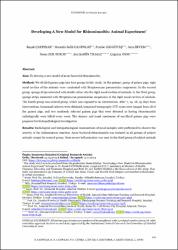| dc.contributor.author | Çaypınar Eser, Başak | |
| dc.contributor.author | Canpolat, Mustafa Salih | |
| dc.contributor.author | Güneş, Pembe Gül | |
| dc.contributor.author | İrvem, Arzu | |
| dc.contributor.author | Zer Toros, Sema | |
| dc.contributor.author | Şahin Yılmaz, Aslı | |
| dc.contributor.author | Oysu, Çağatay | |
| dc.date.accessioned | 2023-09-12T20:40:07Z | |
| dc.date.available | 2023-09-12T20:40:07Z | |
| dc.date.issued | 2023 | en_US |
| dc.identifier.issn | 2536-4499 | |
| dc.identifier.issn | 2602-2605 | |
| dc.identifier.uri | https://hdl.handle.net/11363/5506 | |
| dc.description.abstract | Aim: To develop a new model of acute bacterial rhinosinusitis.
Method: We divided guinea pigs into four groups in this study. In the primary group of guinea pigs, right
nasal cavities of the animals were vaccinated with Streptococcus pneumoniae suspension. In the second
group, sponge strips saturated with sterile saline into the right nasal cavities of animals. In the third group,
sponge strips saturated with Streptococcus pneumoniae suspension in the right nasal cavities of animals.
The fourth group was control group, which was exposed to no intervention. After 7, 14, 28, 35 days from
interventions, intranasal cultures were obtained, computed tomography (CT) scans were imaged from all of
the guinea pigs, and two randomly selected guinea pigs that were detected as having rhinosinusitis
radiologically were killed every week. The sinuses and nasal specimens of sacrificed guinea pigs were
prepared for histopathological investigation.
Results: Radiological and histopathological examinations of nasal samples were performed to observe the
severity of the inflammatory reaction. Acute bacterial rhinosinusitis was induced in all groups of subject
animals except the control group. More severe inflammation was seen in the third group of subject animals compared to the first and second groups. No inflammatory reaction was found in the control group. We also
evaluated the normal flora of guinea pigs.
Conclusion: The guinea pig is certainly a true model for developing rhinosinusitis. Guinea pigs should be
considered as an alternative model for further potential studies of genetics and inflammation, even though
surgical manipulation is limited. | en_US |
| dc.description.abstract | Amaç: Yeni bir akut bakteriyel rinosinüzit modeli geliştirmektir.
Yöntem: Çalışmada kobay hayvanlar dört gruba ayrılmıştır. Birinci gruptaki hayvanların sağ nazal
kavitelerine Streptococcus pneumoniae süspansiyonu damlatılmıştır. İkinci grupta, steril serum emdirilmiş
merosel şeritler hayvanların sağ nazal pasajlarına pasajı kapatacak şekilde yerleştirilmiştir. Üçüncü grupta,
Streptococcus pneumoniae emdirilmiş merosel şeritler hayvanların sağ nazal kavitelerine yerleştirilmiştir.
Dördüncü grup ise herhangi bir girişim veya işlem yapılmayan hayvanların bulunduğu kontrol grubudur.
Girişimleri takiben 7., 14., 28., 35. günlerde intranazal kültürler incelenmiş, bilgisayarlı tomografi (CT)
görüntüleri tüm kobay hayvanlarından alınmış, ve radyoloji olarak rinosinüsit tespit edilen hayvanlardan iki
tanesi rastlantısal olarak seçilerek her hafta dekapite edilmiştir. Sakrifiye edilen kobayların sinüsleri ve nazal
spesimenleri histopatolojik olarak incelenmiştir.
Bulgular: Histopatolojik ve radyolojik incelemelerin yapıldığı nazal örneklemeler inflamatuar reaksiyonun
ciddiyetini gözlemlemeyi sağlamıştır. Akut bakteriyel rinosinüzit, kontrol grubu hariç tüm gruplardaki
kobaylarda indüklenmiştir. Üçüncü gruptaki kobaylarda ilk iki gruba nazaran daha ciddi bir inflamasyon
gözlenmiştir. Kontrol grubunda herhangi bir inflamatuar reaksiyon bulunmamıştır. Ayrıca kobay
hayvanlarının normal florası da incelenmiştir.
Sonuç: Kobay hayvanı deneysel olarak rinosinüzit oluşturmak için çok uygun bir hayvan deneyi modelidir.
Kobay hayvanı cerrahi manipülasyondaki kısıtlılığa rağmen, ilerdeki potansiyel genetik ve inflamasyon
çalışmaları için alternatif bir model olacaktır. | en_US |
| dc.language.iso | eng | en_US |
| dc.publisher | İstanbul Gelişim Üniversitesi Yayınları / Istanbul Gelisim University Press | en_US |
| dc.relation.isversionof | https://doi.org/10.38079/igusabder.1288982 | en_US |
| dc.rights | info:eu-repo/semantics/openAccess | en_US |
| dc.rights | Attribution-NonCommercial-NoDerivs 3.0 United States | * |
| dc.rights.uri | http://creativecommons.org/licenses/by-nc-nd/3.0/us/ | * |
| dc.subject | Sinusitis | en_US |
| dc.subject | rhinosinusitis | en_US |
| dc.subject | guinea pig | en_US |
| dc.subject | animal experiment | en_US |
| dc.subject | Sinüzit | en_US |
| dc.subject | rinosinüzit | en_US |
| dc.subject | kobay hayvanı | en_US |
| dc.subject | gine pig | en_US |
| dc.subject | hayvan deneyi | en_US |
| dc.title | Developing A New Model for Rhinosinusitis: Animal Experiment | en_US |
| dc.title.alternative | Yeni Bir Rinosinüzit Modeli Geliştirmek: Bir Hayvan Deneyi | en_US |
| dc.type | article | en_US |
| dc.relation.ispartof | İstanbul Gelişim Üniversitesi Sağlık Bilimleri Dergisi | en_US |
| dc.department | Sağlık Bilimleri Fakültesi | en_US |
| dc.authorid | https://orcid.org/0000-0002-3782-4738 | en_US |
| dc.authorid | https://orcid.org/0000-0001-6163-4769 | en_US |
| dc.authorid | https://orcid.org/0000-0002-4982-5156 | en_US |
| dc.authorid | https://orcid.org/0000-0003-1307-4538 | en_US |
| dc.authorid | https://orcid.org/0000-0003-3125-732X | en_US |
| dc.authorid | https://orcid.org/0000-0002-7846-9453 | en_US |
| dc.authorid | https://orcid.org/0000-0002-6756-8456 | en_US |
| dc.identifier.issue | 20 | en_US |
| dc.identifier.startpage | 419 | en_US |
| dc.identifier.endpage | 430 | en_US |
| dc.relation.publicationcategory | Makale - Ulusal Hakemli Dergi - Kurum Öğretim Elemanı | en_US |
| dc.contributor.institutionauthor | Çaypınar Eser, Başak | |



















